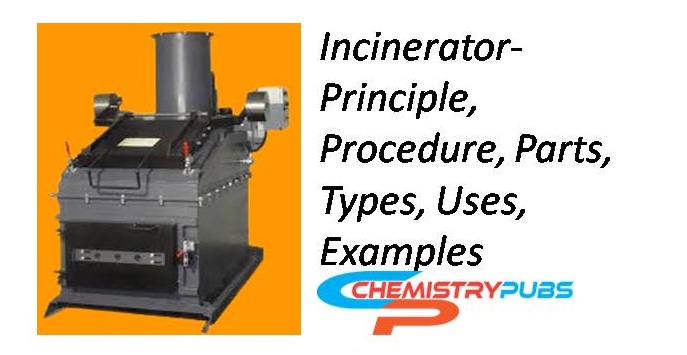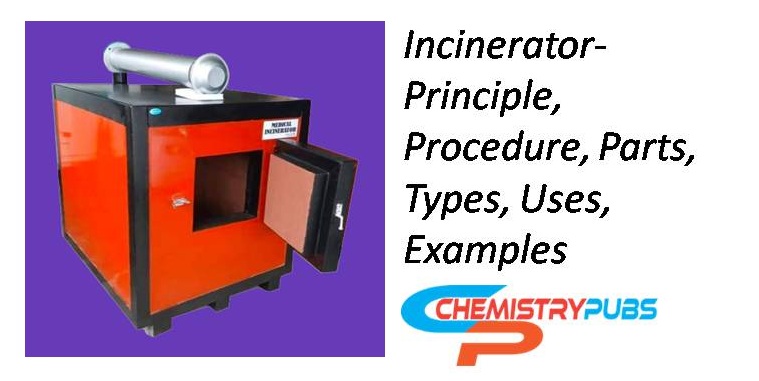An incinerator is one type of furnace that is used for burning dangerous items in a combustion chamber at temperatures high enough to eliminate pollutants is known as incineration. It is generally used where there is a large-scale accumulation of waste and when treating bulky heterogeneous waste needs treatment.
It has the ability to treat various hazardous pollutants, including soil, sludge, liquids, and gases. The final byproducts of the incineration process are ash, heat, and combustion gases. This process helps to remove various dangerous substances, including solvents, PCBs (polychlorinated biphenyls), and pesticides from the samples.
It can dispose of solid, liquid, and gaseous waste from manufacturing processes. Air pollution control technology is used by modern incinerators to reduce the harmful effects on our environment.
Principle of Incinerator
There is a primary combustion chamber for burning solid waste or sludge oil. This primary combustion chamber includes a burner that receives diesel oil to ignite it initially. Then it receives the sludge oil until it ignites, manually or automatically turned off. Then the atomizing air is received by the sludge burner which facilitates the effective combustion.
There exists a pressure-regulating valve on the sludge return line that can be used to control the amount of sludge that enters the conversion chamber. It begins to burn when the primary burner’s heat is applied, and the sludge oil may also catch fire. A wall of ceramic heavy-duty refractory liners is used to separate the primary and secondary combustion chambers. It can give the solid waste into the incinerator through the feeding door for proper combustion continues as usual.

Operating procedure
The solid waste or sludge oil can be burned in the primary combustion chamber of the incinerator. The secondary combustion chamber is related to burning off any unburned exhaust fumes. A primary burner in the primary combustion chamber of this instrument relates to receiving diesel oil to ignite it initially.
Then it should be turned off manually or automatically. The sludge burner of the incinerator receives atomizing air and helps with proper combustion. Apressure-regulating valve is supplied on the sludge return line for controlling the amount of sludge entering the conversion space. The heat of the primary burner helps to create the solid waste to dry out and begin burning, as well as ignite the sludge oil. The primary combustion chambers optimize the solid waste’s drying and burning.
Parts of Incinerator
There have many important parts of this instrument which are given below:
Primary chamber: The various garbage will be fed into the primary chamber and burned for the first time there. The waste gets vaporized in this chamber.
Secondary chamber: The volatile or gasified substance can be transferred to the secondary chamber for completing the combustion process. It has more temperature than the primary chamber.
Flue Stack: This stack is also called “chimney” which applies to reduce the harmful effect on our environment.
Control panel and thermocouples: The control panel and thermocouples regulate this device for good operation.
Burners: Burners are used to warm the incinerator up and are often turned off throughout the burning process.
Fuel tanks: These tanks are used for storing fuel. They have direct lines into the tank for proper use.
Types of Incinerator
There have various types of this instrument such as multiple hearths, moving grate, liquid injection, catalytic combustion chambers, waste gas flare incinerators, rotary kiln incinerators, and fixed grate incinerators.
Applications of Incinerator
Incinerators are used in laboratories, hospitals, and health clinics to destroy and neutralize medical waste. They can be used to dispose of animal wastes, including carcasses, waste, and byproducts, thereby preventing the spread of infection and viruses.
It is possible to destroy harmful wastes from sites such as mining, small communities, and military operations by incinerators. Nanomaterial wastes such as consumer products in municipal solid waste, wastes from nanotechnology research and development, hazardous wastes, etc. are destroyed with the help of incinerators.
Advantages of Incinerator
It helps to reduce the total amount of garbage by up to 90% and the solid portion of the original waste by up to 70–75%. It can be facilitated and improved upon significantly through the incineration process. A definite amount of energy can be produced by this device.
It requires less space to use this apparatus. It is safer and better for the environment because they don’t emit methane. It helps to kill hazardous bacteria and chemicals to protect our environment.
Limitations of Incinerator
The various part of this apparatus requires high expenses, which drives up the cost of the installation procedure. It emits fewer pollutants than landfills do, they nonetheless have a considerable impact on pollution, especially in the vicinity.
It can create various long-term negative health effects like cancer, birth defects, reproductive dysfunction, neurological issues, and other conditions for using waste incinerators in communities.
Precautions of Incineration
It should avoid cross-contamination, scrapes, and punctures from sharps. It should use heavy-duty gloves and full-body aprons during operation time. It must have PPE kits since the extremely high temperatures pose a serious risk to everyone involved. Proper shade of safety glass should be used at the time of burning.
References
1.Swithenbank, J., Nassezadeh, V., Goh, R., & Siddall, R. G. (1999). Fundamental principles of incinerator design. Developments in Chemical Engineering and Mineral Processing, 7(5‐6), 623-640.

